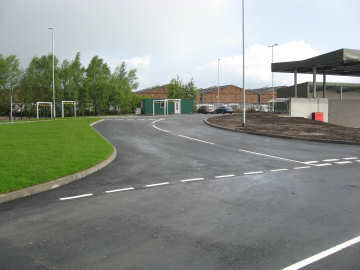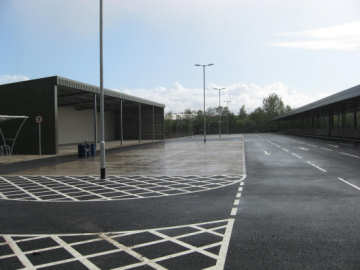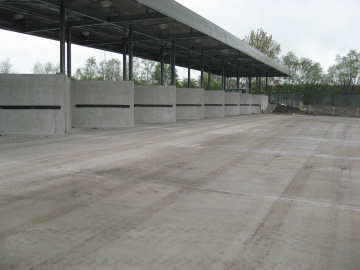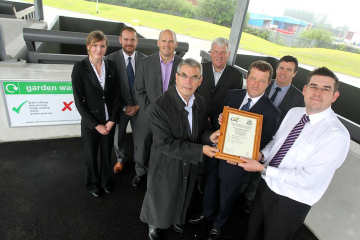Huyton Household Waste Recycling Centre |
|
Whole Project award
Project Team
Client: Merseyside
Recycling and Waste Authority
Design: Shepherd
Gilmour Infrastructure Ltd
Construction: Barhale
Construction Plc
The Project
Merseyside Recycling and Waste Authority (MRWA) and Veolia Environmental Services have officially opened the new £1.5m Huyton Household Waste Recycling Centre (HWRC) on Wilson Road, Knowsley.
The new facility has been built on the 1.7 hectare brownfield site of a former HGV depot on Wilson Road, within the Huyton Industrial Estate, replacing an existing older Recycling Centre on nearby Ellis Ashton Street. The new centre features a central reinforced concrete retaining wall in herringbone configuration, which separates the public drop off area from the commercial skips. A separate steel frame building will receive Waste Electrical and Electronic Equipment (WEEE). Further surfacing, drainage, landscaping and access/egress works completed the build.

The new Huyton Centre has the capacity to receive up to 20,000 tonnes of householders’ waste and recyclable materials each year. Members of the public will be able to use the Recycling Centre to bring all sorts of household items from paper, cardboard and bottles, to larger items (such as white goods, televisions and furniture) and lots more. An increased number of larger containers, plus more queuing space on site for cars and the provision of an overhead weather-protection canopy, will make it more convenient for members of the public to dispose of recyclable and waste items. It is hoped the new facility will increase operational efficiency and assist in improving recycling rates.
Development of the site was designed by Shepherd Gilmour Infrastructure and was undertaken by Barhale Construction Plc, who built the similar South Sefton Recycling facility for MRWA in 2004.
In the spirit of sustainability and sustainable construction, MRWA considered the nature and scope of the HWRC to be ideal for the CEEQUAL Award Scheme. It was therefore a contract requirement for the contractor and the project team to commit to achieve a minimum ‘Very Good’ score, aspiring to ‘Excellent’. Barhale consequently allocated sufficient resources to the project to push the projects sustainability credentials and aid associated evidence gathering.

Challenges faced
Land Use & Landscape Issues
The project transformed the previously derelict brownfield site back into productive use. MRWA site selection procedure was a rigorous point scoring system which had ensured environmental sensitivities such as visual impact associated with a waste processing centre and archaeology were avoided altogether. Detailed conceptual design from MRWA took into account neighbouring landscaping details to ensure the new HWRC fitted in well with the local character of the surrounding industrial estate. Further geo-environmental and arboricultural surveys ensured appropriate protection of existing trees, soil and water resources.
Ecology and Biodiversity
The ecological value of the site prior to construction was low to negligible. On completion of the works there was more than 75% net increase in area of wildlife habitat due to the inclusion of large areas of semi-improved grassland, further tree planting, bird and bat nest boxes, and reed bed vegetation in the two attenuation ponds.
Water Resources and the Water Environment
Logwood Mill Brook runs along the eastern boundary of the site. The site drainage was designed so that the rainwater falling onto the main canopy and the WEEE building could be harvested and stored as grey water for wash down maintenance of the hard standing. This reduced the project’s operational demand on the potable water supply. Should the rainwater harvesting tank exceed capacity, an outfall pipe was installed directing flows to Logwood Mill Brook.
The surface water runoff draining from the large tarmacked and concreted areas was directed to public combined sewer. However, the infrastructure owner limited the level of flow allowance to 20 litres per second. In order to accommodate excess flows from various rainfall events, including a 20% allowance for climate change, two onsite attenuation ponds were constructed and planted with reed beds which act as natural filtration media.

Energy and Carbon
Concrete was the most significant contributor to the project's embodied carbon, followed by gas oil, asphalt, steel bar & rod, and plastics. The project team explored different options for reducing the embodied carbon and concluded that to opt for a polypropylene fibre re-enforced concrete would eliminate the need for the steel rod & bar, as well as reduce the overall volume of concrete needed by 7.5%. Use of pre-fabricated concrete units also helped reduce the embodied carbon of the project
The total embodied carbon of the completed project was an estimated 823 T fossil CO2e, a reduction of 9.8% on the original calculation.
Solar panels were installed to provide renewable energy for site lighting and welfare facilities. This combined with smart technology, such as time clock override to lighting circuits and automatic occupancy heating and light controls, ensures minimal electricity use from mains
Transport
Barhale procurement team gave preference to locally available material sources where possible and practical. Huyton's procurement schedule showed that 92% of materials came from within a 10 mile radius of the site (schedule covered more than 90% suppliers by value). It was not possible to obtain the more specialist materials (e.g. rainwater tank and hydrobrake) locally which accounted for the 8% materials more than 10 miles away.
Waste Management
Existing hard standing was broken out and processed using an onsite crusher to use in the new project’s foundations. 100% reuse of site won materials reduced the project’s demand on virgin material, and in turn reduced the projects waste output and impact on the local road network. In total, 97% of waste generated on site was diverted from land fill through segregation and reuse.
Effects on Neighbours and Relations with the Local Community
Barhale achieving ‘a very good site’ score for Huyton from the Considerate Constructor’s Scheme.
The construction works follow a public consultation during 2010 by MRWA which included information open days and a mail-out to 16,000 local residents and businesses. Barhale continued public consultation through a letter drop to local businesses within the industrial estate to keep them informed of activities and the end result.
To what extent did the use of CEEQUAL influence your project?
CEEQUAL helped the project to drive environmental performance leading up to and during construction activities, and then quantitatively gauge the project’s achievement. Participating in the scheme has allowed all three organisations to develop and improve their sustainability approach for future projects.


